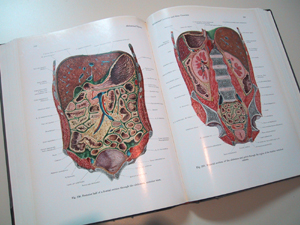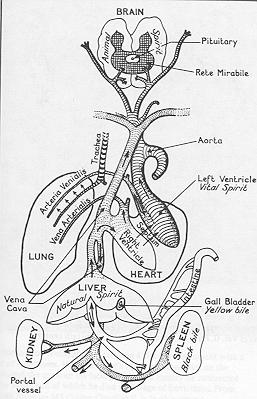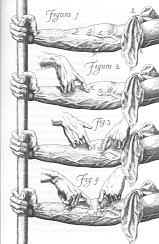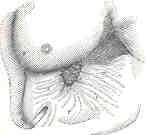Learning Outline
Mini Lesson:History & Culture
The Study of the Human Body
 “Dispel from your mind the thought that an understanding of the human body in every aspect of its structure can be given in words; the more thoroughly you describe the more you will confuse… I advise you not to trouble with words unless you are speaking to blind men.” — Leonardo da Vinci
“Dispel from your mind the thought that an understanding of the human body in every aspect of its structure can be given in words; the more thoroughly you describe the more you will confuse… I advise you not to trouble with words unless you are speaking to blind men.” — Leonardo da Vinci
Western and Eastern traditions
We follow the western tradition that evolved first in Europe
In different regions of the west, perspectives sometimes differ
Other traditions in the middle east and far east evolved at roughly the same time and only now are coming together to form a shared perspective
Latin language
- Latin, the language of the ancient Roman Empire, became the primary language of scholars in the west until the 20th century, because everyone who could read learned to read Latin before their own language
- Most terminology in science, but especially in human biology, is therefore Latin in origin and usage
- Latin borrows much from the ancient Greek language, and therefore so does scientific terminology
- root – main part of the word
- prefix – word part added to the front of a root
- suffix – word part added to the end of a root
- Example
- postsynaptic (root is “-synapt-” prefix is “post-” suffix is “-ic”)
- Term that use a person’s name (usually whomever first identified it) or a place (usually the location of its discovery)
- Useful to learn history, but not as useful as a descriptive term for day-to-day use
- Many eponyms are now being replaced with Latin-based descriptive terms
- If you want to know more about a person in an eponym click here
- When eponyms are used, it is preferable to avoid the possessive form
- For example, Henle loop is better than Henle’s loop or loop of Henle
- For medical conditions, the AMA (American Medical Association) style does not use the possessive form (‘s)
- Parkinson disease is proper whereas Parkinson’s disease is improper (in the AMA style)
- This style for eponyms is used in this course (and in our textbook)

Culture changes
Culture changes over time
Culture is different among different peoples at the same time
Culture influences the way we see the world and ourselves; it shapes the way we think
Culture influences the way we look at the human body, what questions we ask about it, and how we answer those questions
- For example, whether or not cadavers (human remains used for study) are dissected or not has depended upon the norms of the culture: it is acceptable and encouraged now, but not during the middle ages
- It has been acceptable to use animals for live experimentation but that may be changing right now in our own culture
- Research that involves sex/reproduction—or whose value is not immediately apparent to nonscientists—is criticizied for being immoral or silly
Some ethical questions . . .

Assuming it contains useful illustrations, do you think this atlas should still be used?
The Visible Human Project sponsored by the NLM (National Library of Medicine) is an ongoing effort to use modern imaging techniques with cadavers to produce digital data that can be used for a variety of research and educational purposes. The first body used in the project, the Visible Man, belonged to a man executed by U.S. government. The second body used was that of a normal adult female.
- The National Library of Medicine’s Visible Human Project
- The Visible Human Project – Images & Animations
Considering the fact that a significant number of people are opposed to execution, do you think there are ethical concerns about using images from the Visible Human Project?

You can visit the Body Worlds web site at BODYWORLDS-Home
What you do you think about Body Worlds? Have you seen one of their exhibits? Is it ethical to exhibit human bodies in public in this manner? Does it serve education or science, or is it strictly asthetic (artistic)?
Mary Roach’s book Stiff: The Curious Lives of Human Cadavers is a humorously written but scientifically accurate description of what happens to the human body after death. It includes a chapter on the educational/anatomical uses of human bodies. Highly recommended reading!
Major thinkers in the western tradition
This is an outrageously abbreviated sampling of major figures.
Aristotle (384-322 BCE) of Greece
“All men by nature desire to know.”—Aristotle (in Metaphysics)
Along with his contemporary scientist-philosophers, Aristotle thought arteries contained air and veins carried blood. He had other “strange” ideas but was roughly accurate as far as the general anatomy of the human body.
- Recognized that bodies are made of parts, which in turn are made of simpler parts
- Recognized that similar organs in different organisms probably have similar functions
- Thought the brain cooled the body and the heart heated it
- Thought that the heart was the location of the mind, will, and emotions
Aristotle and others of his era did not rigorously question observations, as we do today.
“. . . the heart is placed in the center; in man it is rather on the left side, inclining a little from the division of the mammae towards the left breast in the upper part of the chest; it is not large; its whole form is not long, but rather round, except that the extremity ends in a point. It has three cavities, as I have said. The greatest is that ton the right, the least on the left, the middle one is of intermediate size. They are all perforated towards the lungs.” —From Aristotle’s History of Animals (Chapter XIV)
Claudius Galen (129-199 CE) of Pergamon (now Turkey) (later, moved to Rome)
“Employment is nature’s physician” —Claudius Galen
Greek physician in the Roman Empire who performed experiments to prove arteries contain blood (but thought the heart was a single—not double—pump)
Many of Galen’s conclusions were wrong because he used mostly animals after an early career using humans at a gladiatorial school outside Rome
- Human dissection was forbidden in ancient Rome
Galen was considered “the authority” until the Renaissance
- During the Middle Ages, questioning Galen was questioning authority and because authority came from God, it was heresy and punishable by death —so NOBODY questioned Galen’s conclusions
Diagram of Galen’s concept of blood flow

Andreas Vesalius (1514-1564 CE) of Brussels (later Padua, Italy)
Flemish anatomist willing to “use his own eyes” in human dissections correcting over 200 mistakes of Galen
During the middle ages, everyone had simply trusted Galen, but Vesalius and others during the Renaissance began to question and correct Galen
- Vesalius was one of the first to dissect cadavers himself (rather than rely on others or on animal dissections); even Leonardo da Vinci and other “artist-anatomists” didn’t do their own dissection (of course, they lived nearly twice as long because they weren’t exposed to infections in the dead bodies)
Vesalius was obsessed with dissections, even stacking up cadavers in his bedroom as a medical student in Paris. Later in his life, he told his students to keep a list of their really sick patients so he’d know where to go to get a freshly dead body (yikes)
Published Concerning the Structure of the Human Body – De Corporis Humani Fabrica in 1543 (first “modern” human anatomy text) with detailed illustrations by Jan Stephan van Calcar (student of Titian) The Illustrations from the Works of Andreas Vesalius of Brussels
- This book was published the same year as Copernicus’s text, marking this year as the beginning of the “Scientific Revolution”
“It is perfectly clear to me that my attempt will have all too little authority because I have not yet passed the twenty-eighth year of my life; it is equally clear that, because of the numerous indications of the false dogmas of Galen, it will be exceedingly unsafe from the attacks of conservatives, who, as with us in the Italian schools, have constantly avoided anatomy, and who, being old men, will be consumed with envy because of the correct discoveries of the young, and will be ashamed at having been blind thus far, along with other followers of Galen.” —Vesalius
Medieval dissection.
Note that the professor is in a chair while the dissector receives instruction.
Vesalius. (click to enlarge)
Notice that Vesalius has come down from the podium and does his own dissections
Francis Bacon (1561-1626 CE) of Great Britain
“Knowledge is power.” —Francis Bacon
“Truth is the daughter of time, not of authority.” —Francis Bacon
Published The New Organon in 1620
Argued that inductive logic is better in science than deductive logic
- Induction – making general conclusions from specific facts or observations
- Deduction – making conclusions by inference from stated premises; drawing specific conclusions from general theories
Some consider Bacon the first to describe “the scientific method”
William Harvey (1578-1657 CE) of Great Britain
English physician who published The Anatomical Exercises: De Motu Cordis (1628) and De Circulatione Sanguinis (1649)
Figure (below) shows one of many experiments that Harvey documents in his thorough proof that the heart is a double pump and how blood actually circulates.
Harvey is credited with beginning modern physiological research and experimentation
William Beaumont (1785-1853 CE) of the United States (eventually, St. Louis MO)
Beaumont was an American army surgeon who, while stationed at Ft. Mackinac, Michigan, treated the 18-year-old Canadian Alexis St. Martin after an accidental short-range shotgun blast at his home next to the fort.
- The wound did not heal completely (see figure) and Beamount carefully recorded many experiments on gastric digestion in Experiments and Observations on the Gastric Juice: and the Physiology of Digestion
(1833)
“August 1, 1825. At 12 o’clock M., I introduced through the perforation, into the stomach, the following articles of diet, suspended by a silk string, and fastened at proper distances, so as to pass in without pain—vis.: a piece of high seasoned a la mode beef; a piece of raw, slated, fat pork; a piece of raw, salted, lean beef; a piece of boiled, salted beef; a piece of stale bread; and a bunch of raw, sliced cabbage; each piece weighing about two drachms; the lad continuing his usual employment about the house.
At 1 o’clock p.m., withdrew and examined them—found the cabbage, bread, pork, and boiled beef about half digested; the other pieces of meat unchanged. Returned them into the stomach.
At 2 o’clock p.m., withdrew them again—found the cabbage, bread, pork, and boiled beef, all cleanly digested, and gone from the string; the other pieces of meat but very little affected. Returned them to the stomach again.” —Wm. Beaumont
“This experiment is important, in a pathological point of view. It confirms the opinion, that undigested portions of food in the stomach produce all the phenomena of fever; and is calculated to warn us of the danger of all excesses, where that organ is concerned.”—Wm. Beaumont
Some controversy later developed over the use of human subjects; St. Martin kept returning for more experiments when he needed money, even going down to St. Louis occasionally after Beaumont moved there.
Beaumont is credited for being a pioneer in rigorous experimentation and detailed observation
FYI After retiring from the army, Wm. Beaumont was asked to be the first head of St. Louis University’s Medical School but he refused. He did leave a legacy to the school, however, and the SLU medical school was at one time named for him.
Mssr. St. Martin’s wound.
Open wound in stomach of the young Alexis St. Martin
Alexis St. Martin at age 81. (click to enlarge)
The unhealed wound is still visible.
Listen to a story about Beaumont’s experiments:
Claude Bernard (1813-1877 CE) of France
Bernard summarized modern principles of the scientific study of human biology in 1865 in An Introduction to the Study of Experimental Medicine
Validates knowledge from proving hypotheses wrong
Bernard also made groundbreaking discoveries in the function of pancreatic juice, the existence of muscle that control blood vessel dilation, actions of curare and other drugs in neuromuscular function, and liver function
Bernard also was the first to articulate the concept of “relative constancy” of the body —or homeostasis— a topic discussed in the Mini Lesson: Homeostasis.
Modern times
The 2003 Nobel Prize in Physiology or Medicine was awarded to two scientists for a breakthrough in the way that the way that the human body is studied:
for their discoveries concerning “magnetic resonance imaging”
Imaging of human internal organs with exact and non-invasive methods is very important for medical diagnosis, treatment and follow-up. This year’s Nobel Laureates in Physiology or Medicine have made seminal discoveries concerning the use of magnetic resonance to visualize different structures. These discoveries have led to the development of modern magnetic resonance imaging, MRI, which represents a breakthrough in medical diagnostics and research.
Atomic nuclei in a strong magnetic field rotate with a frequency that is dependent on the strength of the magnetic field. Their energy can be increased if they absorb radio waves with the same frequency (resonance). When the atomic nuclei return to their previous energy level, radio waves are emitted. These discoveries were awarded the Nobel Prize in Physics in 1952. During the following decades, magnetic resonance was used mainly for studies of the chemical structure of substances. In the beginning of the 1970s, this year’s Nobel Laureates made pioneering contributions, which later led to the applications of magnetic resonance in medical imaging.
—from nobelprize.org

FYI Historical Anatomies on the Web is an exhibit of interesting historical illustrations from famous anatomists.
This is a Learning Outline page.
Did you notice the EXTRA menu bar at the top of each Learning Outline page with extra helps?
Readings, References, & Resources
A&P Core
Betts, J. G., DeSaix, P., Johnson, J. E., Korol, O., Kruse, D. H., Poe, B., Wise, J. A., Womble, M., & Young, K. A. (2013). Anatomy and physiology.
Khan Academy. (n.d.). https://www.khanacademy.org/science/health-and-medicine
Patton, K. T. (2013). Survival Guide for Anatomy & Physiology. Elsevier Health Sciences.
Patton, K. T., Bell, F. B., Thompson, T., & Williamson, P. L. (2022). Anatomy & Physiology with Brief Atlas of the Human Body and Quick Guide to the Language of Science and Medicine. Elsevier Health Sciences.
Patton, K. T., Bell, F. B., Thompson, T., & Williamson, P. L. (2023). The Human Body in Health & Disease. Elsevier Health Sciences.
Patton, K. T., Bell, F. B., Thompson, T., & Williamson, P. L. (2024). Structure & Function of the Body. Elsevier Health Sciences.
Topic Focused
Coming soon!
Last updated: February 16, 2025 at 17:16 pm











